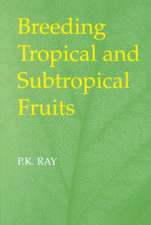The Search for Wild Relatives of Cool Season Legumes: SpringerBriefs in Plant Science
Autor Gideon Ladizinsky, Shahal Abboen Limba Engleză Paperback – 16 apr 2015
Din seria SpringerBriefs in Plant Science
-
 Preț: 345.63 lei
Preț: 345.63 lei -
 Preț: 379.09 lei
Preț: 379.09 lei -
 Preț: 379.09 lei
Preț: 379.09 lei -
 Preț: 375.23 lei
Preț: 375.23 lei -
 Preț: 377.18 lei
Preț: 377.18 lei -
 Preț: 376.80 lei
Preț: 376.80 lei -
 Preț: 378.71 lei
Preț: 378.71 lei -
 Preț: 379.09 lei
Preț: 379.09 lei -
 Preț: 376.59 lei
Preț: 376.59 lei -
 Preț: 374.30 lei
Preț: 374.30 lei -
 Preț: 381.59 lei
Preț: 381.59 lei -
 Preț: 375.07 lei
Preț: 375.07 lei -
 Preț: 349.10 lei
Preț: 349.10 lei -
 Preț: 379.86 lei
Preț: 379.86 lei -
 Preț: 479.67 lei
Preț: 479.67 lei -
 Preț: 441.47 lei
Preț: 441.47 lei -
 Preț: 375.45 lei
Preț: 375.45 lei -
 Preț: 376.59 lei
Preț: 376.59 lei -
 Preț: 377.73 lei
Preț: 377.73 lei -
 Preț: 378.71 lei
Preț: 378.71 lei -
 Preț: 376.22 lei
Preț: 376.22 lei - 15%
 Preț: 460.75 lei
Preț: 460.75 lei -
 Preț: 376.80 lei
Preț: 376.80 lei -
 Preț: 410.77 lei
Preț: 410.77 lei -
 Preț: 376.22 lei
Preț: 376.22 lei
Preț: 377.73 lei
Nou
Puncte Express: 567
Preț estimativ în valută:
72.28€ • 75.46$ • 59.82£
72.28€ • 75.46$ • 59.82£
Carte tipărită la comandă
Livrare economică 05-19 aprilie
Preluare comenzi: 021 569.72.76
Specificații
ISBN-13: 9783319145044
ISBN-10: 3319145045
Pagini: 103
Ilustrații: IX, 103 p. 9 illus., 4 illus. in color.
Dimensiuni: 155 x 235 x 10 mm
Greutate: 0.17 kg
Ediția:2015
Editura: Springer International Publishing
Colecția Springer
Seria SpringerBriefs in Plant Science
Locul publicării:Cham, Switzerland
ISBN-10: 3319145045
Pagini: 103
Ilustrații: IX, 103 p. 9 illus., 4 illus. in color.
Dimensiuni: 155 x 235 x 10 mm
Greutate: 0.17 kg
Ediția:2015
Editura: Springer International Publishing
Colecția Springer
Seria SpringerBriefs in Plant Science
Locul publicării:Cham, Switzerland
Public țintă
ResearchCuprins
The Lens Genus.- The Annual Species of the Cicer Genus.- The Pisum Genus.- Legumes with No Documented Genetic Relatives.- Fodder Crops.
Notă biografică
Dr. Gideon Ladizinsky serves as professor emeritus of Genetics and Plant Breeding for The Hebew University of Jerusalem. His research interests include evolution of cultivated crops, chromosomal and genetic diversity in wild relatives, the anatomy and genetics of interspecific hybrid embryo abortion, and gene transfer between wild tetraploid oats and the cultivated hexaploid varieties.
Textul de pe ultima copertă
This work is a result of 40 years of research, mainly by the authors, on wild relatives of seven important cool season legumes. The primary aim of this research was to identifying the potential of wild relatives of these legumes for breeding purposes. Studying the wild relatives of cool season legumes includes evaluation of their taxonomic status, their morphological variation, ecological requirements, exploration of their distribution, and seed collection in their natural habitats. These seeds were used for examining their protein profile as preliminary hints of their affinity to the cultigens. Plants grown from these seeds were used for establishing their karyotype, producing intra- and interspecific hybrids and analyses of their chromosome pairing at meiosis and fertility. The aim of these investigations was the identification of the potential wild gene pool of the domesticated forms. Assessment of genetic variation among accessions, particularly in the genus Lens, was made by isozymes and chloroplast DNA studies.
Caracteristici
Brings together research findings that have been accumulated during the last 40 years, mainly by the authors, on wild relatives of cool season legumes Indicates the wild relatives of lentil, chickpea, common and bitter vetch that can be exploited for breeding Presents biological evidence that pulse domestication proceeded in a unique course, already in the wild Includes supplementary material: sn.pub/extras







